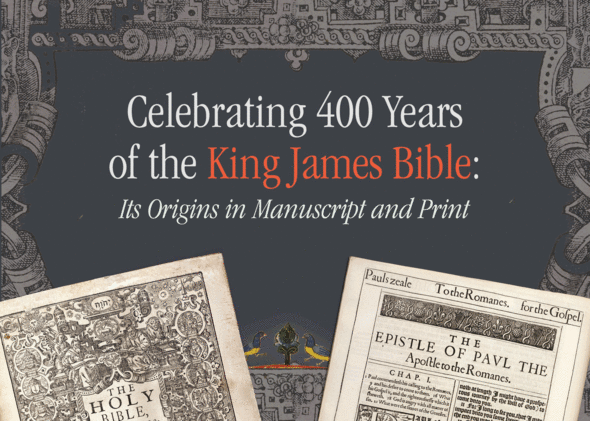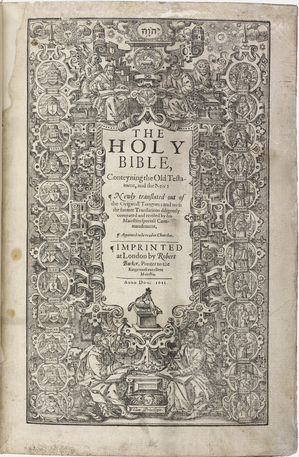U-M Hatcher Library celebrates 400 years of the King James Bible

Image courtesy of UM Harlan Hatcher Graduate Library
For the past several years, the small Audubon Room in the University of Michigan's Harlan Hatcher Graduate Library has become a significant tourist destination in January, when rare documents from the library’s Papyrus Collection and Special Collections Library are displayed for the annual Bible exhibit.
This year's presentation, "Celebrating 400 Years of the King James Bible: Its Origins in Manuscript and Print," traces the ancient written predecessors leading up to the King James Version, the standard English translation of the Christian Bible for 350 years.
According to Pablo Alvarez, outreach librarian and special collections curator, "People are really drawn to the material objects representing something they know so well."
The exhibit does not focus on the scriptures' content but the historical context and materials. While people often say, "Don't judge a book by its cover," Alvarez asserts that sometimes we should judge a book by the materials.
"The object itself will illuminate many things," said Alvarez. "It tells you who produced it and why."
The exhibit can be described in two main stages: the ancient manuscripts, or hand-scribed words on papyrus, vellum or paper, and the printed works of the Middle Ages.
One highlight of the manuscript section is a papyrus codex of the Epistles of Paul from the second century C.E. — the oldest surviving record of the apostle's letters. According to Alvarez, the piece is not only significant for its age, but also for the codex (book) form of the scriptures, allowing the reader to carry the manuscript or browse the collection in full, rather than many separate scrolls. It is remarkable that this manuscript survived through the early centuries of Christian persecution, explained Alvarez.
The exhibit also includes a papyrus Census Declaration dated 119 C.E., documenting a Roman practice described in the Gospel of Luke, and fragments of the book of Deuteronomy from circa 150 C.E.
The second phase of the exhibit moves on to the revolution of the printing press in the mid-15th century, featuring a leaf from the Gutenberg Bible circa 1456, the first ever printed book, with beautiful decorative details.
Other predecessors to the King James Version are also displayed, including a Coverdale Bible, The Great Bible (the first English Bible authorized for public use), a Tyndale New Testament, and a Geneva Bible, the version carried by many Puritans when they came to the New World.

Title page of the first edition of the King James Bible, printed in London in 1611. It reads: "THE HOLY BIBLE, Conteyning the Old Testament, and the New : Newly translated out of the Originall Tongues: and with the former Translations diligently compared and revised by his Majesties speciall Comandement" [sic]
Image courtesy of U-M Harlan Hatcher Graduate library
Two King James Bibles complete the presentation: an original 1611 copy and a 1612 copy with some errors made by the king's printer, Robert Barker.
Alvarez offered some historical context to explain the significance of the King James translation.
After succeeding Elizabeth I to the throne, James faced several factions within the protestant Church of England. He convened the Hampton Court Conference in January 1604 in attempt to create religious uniformity. Suddenly, during this conference, the Puritan leader John Reynolds suggested a new translation of the Bible, and James agreed.
To ensure the translation would be accepted by all branches of English-speaking Christians, James directed 47 scholars to translate the new version. According to the exhibit label:
"The King James Bible succeeded where other translations had not, perhaps due to the fact that the text is neither the work of the single man nor a small group, but of a large number of scholars working cooperatively and with ample time for thorough revision. Their prose is one of the finest example of the literary style of their time, reflecting both a gift for language and an appreciation for the solemnity of their subject."
The Celebrating 400 Years of the King James Bible: Its Origins in Manuscript and Print exhibit is open daily from Jan. 5 through March 20, 8:30 a.m. to 7 p.m. The Audubon Room is located just off the Diag, in the Harlan Hatcher Library Gallery.
The library is also offering a series of related lectures to complement the exhibit. See details in the "More Info" box below.
Pam Stout coordinates Faith coverage for AnnArbor.com. She can be reached at pamstout@annarbor.com.


Comments
David Sanford
Thu, Jan 6, 2011 : 11:57 p.m.
Thanks! A big surprise tied into the 400th anniversary of the 1611 King James Version Bible: Two scholars have compiled the first worldwide census of extant copies of the original first printing of the 1611 King James Version (sometimes referred to as the "He" Bible). For decades, authorities from the British Museum, et al., have estimated that around 50 copies of that first printing still exist. The real number is quite different. For more information, you're invited to contact Donald L. Brake, Sr., PhD, at dbrake1611@q.com or his associate David Sanford at drsanford@earthlink.net
Macabre Sunset
Thu, Jan 6, 2011 : 1:16 p.m.
Really? How about quatracentennial (if that's a word) of hatred? I still think 100 years since the publication of Jennie Gerhardt is far more significant, and with a far lower associated death count. But delete again, silly moderator. Delete away. Then join the pieces of excrement who bombed Times Square because a couple of cartoonists dared criticize their organized religion.
Macabre Sunset
Thu, Jan 6, 2011 : 1:01 p.m.
This is a good idea for a regular feature. This year marks 100 years since the publication of Theodore Dreiser's Jennie Gerhardt, one of the best American novels ever written. I think we should take a moment of silence to reflect on Dreiser's genius.